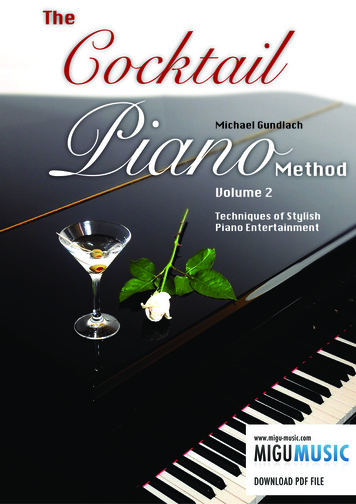
Transcription
www.migu-music.comDOWNLOAD PDF FILE
Table of ContentsExplanation of Contents .6Melody Interpretation—Part 1 .8Altering the Melodic Rhythm . 8Harmony—Part 1 . 11Chord Expansion, Dominants . 11Expanding the Dominant with 6th and flatted 9th . 11Expanding the Dominant with #5 and 9th. 12Combining the two Expanded Dominants . 13Common Harmonic Progressions—Part 1 . 14Adding Chords . 16Fills—Part 1. 19Major Scale Fills . 19Fills, Major Scale with Chromatics . 22Careless Love . 24Harmony—Part 2 .30Playing in Thirds—Part 1 . 30Playing in Thirds, Major Scale . 30Shifting Chromatic Thirds . 31Passing Tones, Minor (7, #7, 8) . 33American Patrol.36Fills—Part 2.42Fills, Six Note Scale . 42Harmony—Part 3 .46Chromatic Chord Shifting . 46Chromatic Chord Shifting, Major Triad, Right Hand . 46Chromatic Chord Shifting, Minor Triad . 48Chromatic Chord Shifting, Dominant Seventh Chord . 49Sixths in the Inner Voices . 50Chromatic Sixth Shifting in the Inner Voices . 51Intros.53We Shall Not Be Moved .56Common Harmonic Progressions—Part 2 .60Passing Chords, Minor . 60Harmony—Part 4 . 67Diminished Passing Chords, Minor . 67Diminished Passing Chords, Major . 68Melodie In F .70
Prelúde . 76Endings .80Harmony—Part 5 . 87Minor Chords, Fourth in the Top Voice . 87Minor Passing Chords, Diminished . 87Santa Lucia .89Fills—Part 3.94Fills, Altered Scale . 94Fills—Part 4.98Fills, Altered Scale with Chromatics . 98Harmony—Part 6 . 101Playing in Thirds—Part 2 . 101Playing in Thirds, Altered Scale. 101Sweet Dreams . 104Harmony—Part 7 . 110Chord Extension, Dominant with #9 . 110Playing in Thirds, diminished .112Pedal Tone Technique .115Summer Feelings . 119Melodic Interpretation—Part 2 . 125Altering the Melody . 125Aura Lee . 127Harmony—Part 8 . 133Shearing Voicings . 133Harmony—Part 9 . 136Modulation . 136Just A Closer Walk With Thee . 140O Holy Night . 146The Left Hand . 151Left Hand Rhythms . 153Chord Charts. 154Altered Scales in 12 Keys . 156
Careless LoveLead SheetTraditionalArr.: Michael Gundlach 2010 MIGU MUSIC“Careless Love” is a simple song that requires good interpretation. Looking at the lead sheet, we notice a verysimple harmony consisting of the I – IV – V major chords and a rather boring melody rhythm. In the arrangedpiano version of “Careless Love” (page 27–29) we implement the material we learned in the previous chapters.In order to better understand these techniques, let s examine and compare some of the measures. Measures6–8 from the lead sheet are well suited for the harmony technique from page 14:written in measures 6–8played, Piano Version, measures 10–12 (and 26–28)24
Fills—Part 2Fills, Six Note ScaleEvery cocktail pianist should strive to have a rich repertoire of fills at his disposal. A short improvised melody canconsist of just three or four notes, or an entire scale. In the chapter “Fills—Part 1”, we used all the notes of themajor scale. As a reminder, here is the C major scale:C major scaleNow we will learn how we can omit one note to form a six note scale. We will omit the fourth:C major scale without fourthThese six notes are well-suited for creating short improvised melodies. All the notes of this scale can be usedwith the chords of the C major scale. We’ll show you how this sounds by practicing the Examples 14a–15c inthree keys:14a42
Harmony—Part 3Chromatic Chord ShiftingCreative pianists are always making interesting changes to a songs harmony, even if it is not notated in thewritten notes. Chromatic chord shifting is an exciting technique. Generally it s possible to shift any chord down(or up) a half-step and return to the original chord. In this chapter we will deal solely with chord shifting down ahalf-step. We have two possibilities:1. We shift only the chord (the notes in the right hand)2. We shift the entire chord (both hands)Chromatic Chord Shifting, Major Triad, Right HandIf you’re playing the right hand melody with chords, chromatic chord shifting is a good possibility, especiallywhen the melody note goes down a half-step and back up. If the melody note is also the third, fifth, or root ofthe chord, chromatic chord shifting is a good option. To understand this better, let s look at a short melodyexample:Third of C majorThe third of the C major chord, the “E”, descends a half-step to “D#” and back up. If we are adding chords tothe melody, we can shift back and forth between C major and B major triads:B major triadC major triad46
Common Harmonic Progressions—Part 2Passing Chords, MinorPassing chords are a very important topic for all cocktail pianists. They can be used to great effect when harmonizing the melody. Simply defined, passing chords are additional chords that can be added, but are not necessarily indicated in the written music. It is possible to insert additional chords to the ones already notated. In thischapter we want to explore which additional chords can be added to a minor chord.1st VariationWe can extend this Dm7 chord by adding an Em7 (or C/E) and an F major chord:writtenplayedDm7Dm7Em7 (C/E) FIf we use the example of a II – V– I cadence in C major, the extension would look like this:writtenDm7playedG7CDm7Em7 (C/E) FG7CIn Examples 30a–32c we’ll see the 1st Variation used in a typical harmonic setting.30a60
Melodie In FLead SheetMusic: Anton RubinsteinArr.: Michael Gundlach 2010 MIGU MUSIC“Melody in F”, a wonderful composition by Anton Rubinstein, is well-suited for cocktail piano. The diminishedchords can be used as passing or added chords. In the Piano Version we see the diminished chord used in 20measures (measures 1, 2, 4, 5, 6, 7, 9, 10, 11, 12, 17, 18, 20, 21, 22, 23, 25, 26, 28, 29). The chord consistsof 2–4 voices. In measure 1 of the Piano Version (page 73), the diminished chord consists of just 2 voices, onbeats 2 and 4:written in measure 170Conversion, Piano Version, measure 1
Melodie In FMusic: Anton RubinsteinArr.: Michael Gundlach39 2010 MIGU MUSIC73
EndingsEnding FillsMany of the common harmonic progressions that we have learned can be readily used for endings. At this pointwe want to look at some ending fills. An ending fill is a short phrase used at the very end of a song.Ending Fills, Two NotesGenerally it’s possible to play a fill using the notes of the chord. We can even create an interesting fill using justtwo notes. If we have a major chord at the end of a song, we can use the root and the third. Adding the rootagain an octave higher makes it more interesting. Now we have a three note pattern, as we see here:RootThirdRootWe can repeat this pattern over several octaves:At the end of the piano version of “Prelúde” (page 79, measure 40) we see this ending fill pattern over amajor chord.If we have a minor chord at the end of a song, we obviously need to play the minor third in our new pattern.Now let’s practice this new ending fill in both major and minor (Examples 41a–c).41a80
Fills—Part 3Fills, Altered ScaleThe altered scale is a wonderful and popular device used by cocktail pianists for fills and improvisation. It’simportant to learn more about this new topic. The altered scale is a dominant scale and fits nicely to the dominant seventh chord. In the altered scale, the fifth and the ninth is raised or lowered. Sometimes you will see theabbreviation “alt” after a chord (e.g. C7alt); it s the pianist s decision how he/she wants to alter the chord. Ifyou raise and lower both the fifth and ninth, you have four alterations in your scale. The altered scale of the G7looks like this:Altered scale, G7b9Root#9b5Third#5SeventhG7As you can see from this example, there is no perfect fifth in the altered scale, rather a diminished fifth (b5) andan augmented fifth (#5). In addition, we have a minor ninth (b9) and a raised ninth (#9). We are also using theroot, third and seventh of the original dominant chord. It’s a good idea to play these three notes in the left hand(omitting the fifth) while playing altered scale fills. Practical Examples 56a–60c will illustrate the sound characterof the altered scale.94
Melodic Interpretation—Part 2As we saw in the chapter “Melodic Interpretation—Part 1” (pages 8–10), there are many ways to modify therhythm of a melody. If you also add changes to the notes of the melody, the possibilities are endless. Thischapter will offer some suggestions to get you started.Altering the MelodyThe first possible melodic variation involves playing a note a half-step lower than the melody tone and returningto the original tone. Using a simple melody with two half notes, it would look like this:writtenplayedorOf course the melody tone can also be varied up a whole step:writtenplayedorBoth melody tones could also be connected using notes form the major scale:writtenplayed125
piano version of “Careless Love” (page 27–29) we implement the material we learned in the previous chapters. In order to better understand these techniques, let s examine and compare some of the measures. Measures 6–8 from the lead sheet are well suited for th










